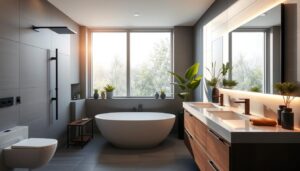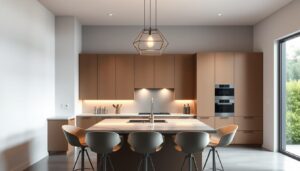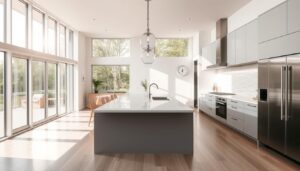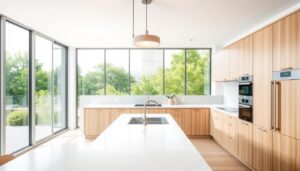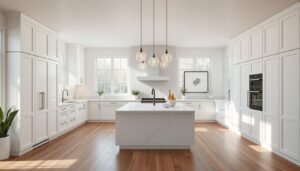Gone are the days of cold, clinical spaces. The coming year brings a shift towards warm, personalised designs that reflect individuality. Think soft textures, earthy tones, and nostalgic touches that make a house feel like a home.
From compact city flats to sprawling country houses, these trends cater to all. Expect a blend of functionality and timeless style, with influences from nature, smart tech, and even retro charm. Whether you’re planning a full makeover or subtle updates, there’s inspiration for every taste.
British homeowners, in particular, will find these ideas adaptable. Many focus on sustainability and clever storage—perfect for modern living. Ready to explore what’s ahead? Let’s dive in.
Key Takeaways
- Warm, personalised designs replace sterile minimalism.
- Trends blend functionality with nostalgic and natural elements.
- Ideas suit both small urban spaces and larger luxury homes.
- Sustainability and smart tech play key roles.
- UK-focused applications ensure practicality for British households.
Introduction to Bathroom Renovation Trends 2025
Modern interiors now prioritise warmth and personality over stark minimalism. The post-pandemic era has reshaped our homes into sanctuaries, where every detail tells a story. For 2025, expect spaces that feel lived-in yet luxurious, with textures and tones that invite relaxation.
Renowned designer Phillip Thomas champions “timeless and comfortable” environments. His approach resonates with UK homeowners who are blending heritage features—like Victorian tiles or exposed beams—with contemporary luxuries. The result? Rooms that feel both nostalgic and fresh.
Mass-produced finishes are losing ground to materials with character. Think handcrafted ceramics, reclaimed wood, or locally sourced stone. These choices reflect individual lifestyles, turning functional areas into personal retreats.
This shift isn’t just about aesthetics. It’s a response to our desire for authenticity. Whether updating a compact city house or a countryside cottage, these design trends ensure every space feels intentional. Keep an eye on these evolving ideas as we explore the trends 2025 will bring.
1. Dark & Moody Colour Schemes
Forget stark whites—2025 embraces rich, immersive colour schemes. Oxblood, forest greens, and charcoal are leading the charge, turning functional spaces into atmospheric retreats. These hues work especially well in period properties, adding depth to high ceilings and ornate details.
Oxblood and Earthy Tones
Oxblood is the standout shade for bold interiors. Pair it with brass fixtures or Portola Paints’ textured plaster to avoid a flat look. Designer Linda Eyles notes:
“In my Cheshire project, Ann Sacks’ oxblood tiles created a jewel-box effect. The key is balancing warmth with reflective surfaces.”
Luxurious Veined Marbles
Nero Marquina marble adds drama without overpowering smaller rooms. Its white veins break up dark surfaces, making it ideal for UK homes with limited light. For a cohesive look, use it on countertops or as statement flooring.
| Material | Best For | UK Tip |
|---|---|---|
| Oxblood tiles | Feature walls | Pair with matte brassware |
| Nero Marquina | Countertops | Use in south-facing rooms |
| Textured plaster | Ceilings | Adds depth to north-facing spaces |
Warning: Dark walls can shrink spaces. Balance them with light-reflecting finishes like polished nickel or glossy tiles. In north-facing rooms, limit dark tones to lower walls or accents.
2. Spa-Inspired Retreats
Transform your daily routine into a luxurious escape with spa-inspired interiors. More UK homeowners are turning their spaces into wellness havens, blending natural materials and soothing technology for a hotel-like experience.
Natural Stone and Textured Tiles
Textured Basalt tiles from British Stone are a top choice for shower floors, offering grip and elegance. For a cost-effective alternative, Victorian Plumbing’s pebble-effect PVC panels mimic nature without the upkeep.
Kara Childress, a leading designer, advocates for *sensorial design*:
“Natural stone isn’t just durable—it connects us to the earth, enhancing relaxation.”
Pair these with underfloor heating for year-round comfort.
Ambient Lighting and Aromatic Elements
Lighting expert Brieanna Cunningham recommends dimmable Astro wall lights with brass accents. Add essential oil diffusers, like those Peltier Interiors uses, to engage multiple senses.
- Steam showers: Demand surges for models rivalling Champneys spas.
- Layered lighting: Combine task, ambient, and decorative fixtures.
- Heated floors: Ensure compatibility with natural stone.
3. Statement Ceilings: The Fifth Wall
Ceilings are no longer an afterthought in interior design. The fifth wall is now a canvas for bold finishes, from dramatic paint to handcrafted tiles. This shift turns overlooked spaces into striking features.
Bold Paint and Intricate Tiling
Farrow & Ball’s “Hague Blue” is a favourite for London townhouses, adding depth to compact rooms. For intricate detailing, British brand Ca’ Pietra offers encaustic tiles that mimic vintage patterns. Designer Eleanor Pritchard notes:
“A ceiling in deep teal or geometric tiles draws the eye up, creating the illusion of height.”
Wooden Panelling and Textured Plaster
Exposed oak beams, like those in a Yorkshire barn conversion, add rustic charm. For modern spaces, MDF panelling—sealed with waterproof finishes—offers a cost-effective alternative. Textured plaster, such as Portola Paints’ options, introduces subtle movement.
| Material | Best For | UK-Friendly Tip |
|---|---|---|
| Encaustic tiles | Period homes | Pair with underfloor heating |
| MDF panelling | Humid areas | Use moisture-resistant primer |
| Textured plaster | Contemporary spaces | Opt for warm, neutral tones |
Budget hack: Anaglypta wallpaper painted in Little Greene’s “Plummett” mimics plaster at a fraction of the cost. Perfect for rental-friendly updates.
4. Hidden and Clever Storage Solutions
Smart storage is revolutionising how we use every inch of our homes. For British homeowners, blending aesthetics with practicality is key. Think recessed niches, multi-functional furniture, and vertical solutions that turn chaos into calm.
Recessed Shelving and Integrated Cabinetry
British Standard’s space-saving cabinets feature built-in LED mirrors, ideal for compact layouts. Retrofit Victorian alcoves with humidity-resistant shelves for a period-appropriate touch. Designer Marcus Fairfax notes:
“Recessed storage preserves floor space while adding architectural interest.”
Over-the-Toilet Storage
The Bath Store’s over-toilet units with integrated towel warmers are a hit in London flats. A recent case study showed a 30% storage gain in a 5m² bathroom. Opt for slim profiles to avoid crowding.
| Solution | Best For | UK-Friendly Tip |
|---|---|---|
| Recessed shelves | Period properties | Use moisture-resistant MDF |
| Over-toilet units | Small spaces | Match tiles to blend seamlessly |
| Magnetic cabinets | Families | Position out of children’s reach |
Pro tip: Lockable recessed units keep medicines secure yet accessible. Pair with matte surfaces for a cohesive look.
5. Wet Rooms for a Seamless Look
Wet rooms are redefining modern spaces with their sleek, barrier-free appeal. Popular in British homes, they merge showers and bathing areas into one cohesive zone. This design maximises space and simplifies cleaning—ideal for compact urban flats or luxury retreats.
Glass-Enclosed Showers and Tubs
Frameless glass panels create an airy, open feel while containing water splash. Shauna Jones, a London-based designer, notes:
“Glass enclosures enhance light flow, making small wet rooms feel expansive. Pair them with textured tiles for grip and visual interest.”
For accessibility, consider low-profile trays or level-entry designs. These cater to the UK’s ageing population while maintaining a minimalist aesthetic.
Creative Tile Designs
Porcelanosa’s large-format tiles reduce grout lines, easing maintenance in hard water areas. Their Manchester showroom showcases bold geometric patterns that elevate bathroom design. For a tactile finish, try matte stone-effect materials from British Stone.
- UK regulations: Tanking (waterproofing) is mandatory—opt for British Gypsum’s systems.
- Heating: Underfloor systems outperform wall-mounted rails for even warmth.
- Maintenance: Vinegar solutions prevent limescale on glass in hard water regions.
Whether you prefer monochrome simplicity or artisanal tiles, wet rooms adapt to any style. Their blend of form and function makes them a standout choice for 2025.
6. Bold Wallpaper and Statement Walls
Walls are taking centre stage in modern interiors, transforming functional spaces into artistic showcases. Gone are the days of plain paint—today’s design embraces vibrant patterns and textures that tell a story. Whether you prefer tropical motifs or heritage prints, there’s a wallpaper to suit every taste.
Patterned Wallcoverings
Graham & Brown’s peel-and-stick papers are revolutionising rental properties. These removable options allow tenants to personalise without permanent changes. For period homes, Morris & Co.’s classic prints—seen in National Trust properties—add timeless charm.
Kara Childress, a leading designer, advises:
“Balance bold patterns with neutral tiles or flooring. Cole & Son’s ‘Palm Jungle’ pairs beautifully with limestone for a harmonious look.”
Pairing with Neutral Flooring
Statement walls demand understated foundations. Consider these winning combinations:
- Geometric prints with large-format porcelain tiles
- Floral designs paired with oak herringbone flooring
- Metallic accents alongside matte concrete-effect surfaces
Ventilation is crucial for papered spaces. Manrose’s humidity-sensing extractor fans prevent peeling in steamy environments. Strategic zoning—like glass screens—also protects delicate wallcoverings.
| Wallpaper Type | Best Pairing | UK Maintenance Tip |
|---|---|---|
| Vinyl | Family homes | Wipe clean with mild detergent |
| Hand-printed | Luxury spaces | Avoid direct water exposure |
| Textured | Contemporary schemes | Use soft brushes for dusting |
Pro tip: Test samples at different times of day. Northern light softens vibrant palettes, while southern exposure intensifies colours.
7. Black Accents for Dramatic Flair
Dramatic black finishes are transforming ordinary spaces into striking sanctuaries. British homes are elevating their bathroom schemes with moody tones, balancing boldness with warmth. Whether through tapware or tiles, these accents create a timeless yet contemporary look.
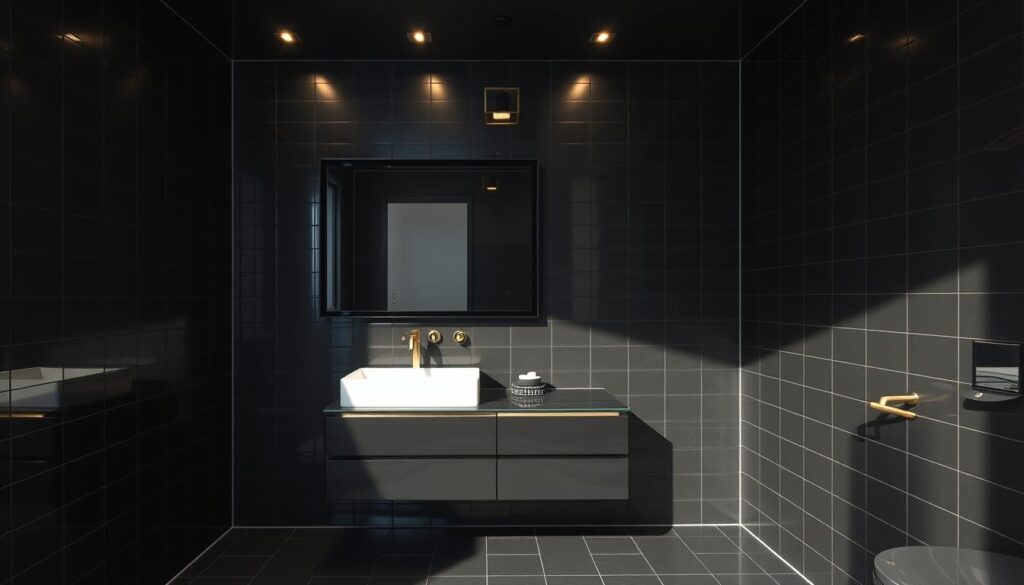
Mixing Brass and White Fixtures
Crosswater’s matte black tapware with brass detailing is a UK favourite. The contrast adds luxury without overpowering smaller rooms. For a cohesive look, pair with white surfaces or neutral tiles.
“Black tapware anchors a space, but brass stops it feeling cold,” notes designer Linda Eyles. “In an Edinburgh project, we used Nero Marquina marble in the shower niche—the veining softens the drama.”
Nero Marquina Marble Tiles
This marble’s white veins prevent dark surfaces from feeling flat. Ideal for shower niches or flooring, it’s both slip-resistant and hardwearing. For budget-conscious updates, Topps Tiles’ porcelain marble-effect range offers a similar aesthetic.
- Anti-smudge coatings: Brands like Crosswater use nanotechnology to minimise fingerprints.
- Lighting: Position LED strips above dark features to enhance depth in low-light rooms.
- Case study: A Glasgow townhouse used Nero Marquina in a wet room, proving its versatility.
Pro tip: Layer textures—think ribbed glass shelves or woven baskets—to add warmth to monochrome schemes.
8. Reclaimed Wooden Vanities
Sustainability meets character with reclaimed wooden vanities making waves in modern homes. These pieces blend rustic charm with contemporary functionality, offering a unique focal point. British homeowners adore their eco-friendly appeal and one-of-a-kind patina.
Vintage Furniture Repurposing
Kara Childress’ Bristol project transformed an 1890s oak dresser into a vanity with integrated sinks. Her tip?
“Sand lightly to preserve original markings—they tell the wood’s story.”
For sourcing, skip big retailers. Reclaim yards or Facebook Marketplace often hide gems like teak railway sleepers or church pews.
Rustic Charm Meets Modern Luxury
Pair weathered materials with sleek tech. A London workshop now fits wireless chargers into drawer tops—perfect for clutter-free countertops. For finishes, Osmo Oil protects against humidity without hiding grain.
- Teak vs. pine: Teak’s natural oils resist warping in steamy environments.
- Marine varnish: Ideal for high-splash zones but requires reapplication.
- Custom touches: Hand-carved pulls or heritage paint colours elevate style.
Pro tip: Test finishes on offcuts first. Some darken timber dramatically, altering the furniture’s character.
9. Immersive Powder Rooms
Powder rooms are no longer just functional spaces—they’re opportunities to make a bold design statement. These compact areas allow for daring choices that might feel overwhelming in larger rooms. Think rich hues, eye-catching fixtures, and theatrical lighting that transforms a cloakroom into a conversation piece.
Dramatic Colour Palettes
Small spaces thrive on deep, immersive palettes. Farrow & Ball’s “Hague Blue” has become a favourite for UK homeowners, as seen in a recent Chelsea townhouse project. Interior designer Amber Guyton advises:
“Dark tones add depth to confined areas. Pair them with metallic accents to prevent the space from feeling cramped.”
For renters, removable tiles like those from Temza offer a temporary way to experiment with bold looks.
Statement Lighting Fixtures
Lighting takes centre stage in powder rooms. Jim Lawrence’s oversized pendant lights create a luxe focal point, while sensor-activated LED strips under floating vanities add a modern twist. Consider these options:
- Antiqued mirrors: Add vintage charm with reflective surfaces.
- Smart mirrors: Feature built-in mood lighting for versatility.
- Geometric sconces: Enhance small spaces with angular designs.
Whether you opt for timeless elegance or cutting-edge tech, powder rooms prove that big impact comes in small packages.
10. Organic Materials and Natural Textures
Nature-inspired interiors are reshaping modern spaces with their warmth and authenticity. Natural materials like wood and stone bring tactile richness, turning functional areas into serene retreats. British designers, including Amy Peltier, champion this approach for its timeless appeal and eco-conscious benefits.
Warm Wood Finishes
FSC-certified oak vanities from UK suppliers like The Wood Veneer Hub offer sustainability without compromising style. Their grain patterns add character, while finishes like Osmo Oil protect against humidity. For a rustic touch, reclaimed beams or sisal mats pair beautifully with smooth pebble basins.
“Wood introduces warmth that synthetic materials can’t replicate,” notes Peltier. “In a Cotswolds project, hemp plaster walls paired with oak created a cohesive, earthy aesthetic.”
Calming Stone Surfaces
Locally sourced limestone outperforms imported travertine in durability and cost. Its subtle veining complements underfloor heating, making it ideal for British climates. For high-splash zones, matte finishes like British Stone’s basalt provide grip and elegance.
- Textural contrast: Combine rough-hewn stone with polished brass fixtures.
- Low maintenance: Sealants like Lithofin MN protect porous surfaces.
- Case study: A Devon eco-home used limestone flooring with recycled glass tiles.
Pro tip: Test samples under different lighting. North-facing rooms benefit from honey-toned wood, while south-facing spaces handle cooler stone palettes.
11. Fun and Playful Fixtures
Injecting personality into functional spaces has never been more exciting. Today’s fixtures blend artistry with utility, turning everyday essentials into conversation starters. From concrete basins to colour-matched taps, these ideas redefine what’s possible.
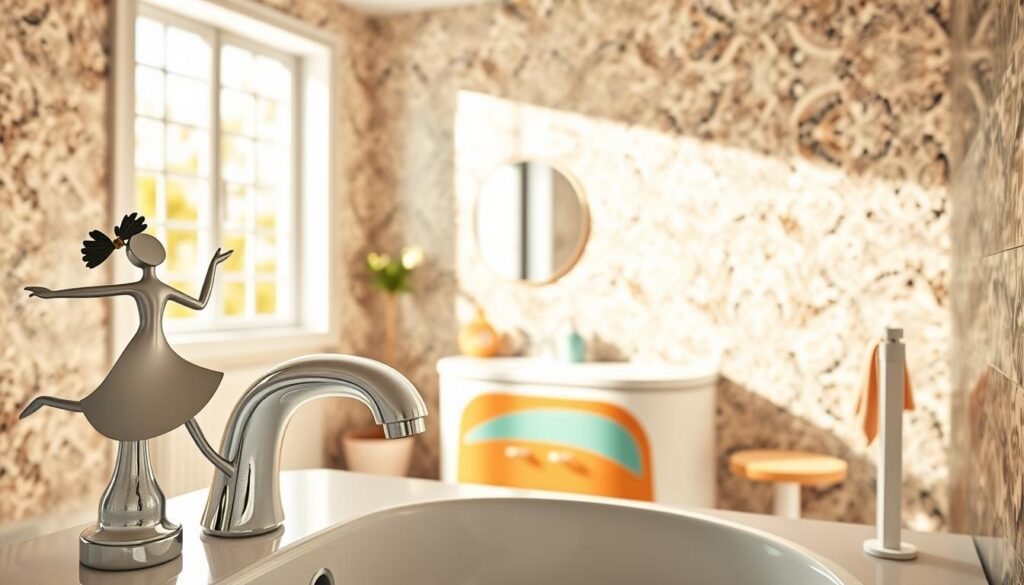
Unusual Colours and Materials
Linda Eyles’ Kast Concrete basins exemplify this shift—their rugged texture contrasts beautifully with sleek brass taps. For families, non-slip versions ensure safety without sacrificing design.
B&Q’s terracotta range adds warmth, while exposed copper piping nods to industrial chic. As Eyles notes:
“Concrete isn’t just durable—it’s a canvas. Hand-pigmented finishes let homeowners tailor pieces to their palette.”
Customisable Faucets
Victorian Plumbing’s colour-matching service lets you coordinate taps with tiles or accessories. Aerated models cut water use by 30%, proving style and sustainability can coexist.
| Material | Best For | UK Consideration |
|---|---|---|
| Concrete | Statement pieces | Seal annually to prevent staining |
| Terracotta | Rustic schemes | Pair with underfloor heating |
| Copper | Industrial looks | Patina develops naturally |
Pro tip: Test small samples first. North-facing rooms suit warm terracotta, while south-facing spaces handle cooler concrete tones.
12. Art Deco and 1930s Revival
The glamour of the interwar period is making a striking comeback in modern interiors. Art Deco’s geometric precision and bold elegance are being reimagined for contemporary homes, blending vintage charm with today’s design trends. From symmetrical tiles to gleaming chrome accents, these elements add timeless sophistication.
Geometric Lighting and Tile
Hexagonal tiles and stepped patterns dominate Deco-inspired spaces. Original 1930s features, like chrome towel rails, are highly sought after at UK reclamation yards. For a modern twist, House of Harlowe’s laser-cut shower screens echo classic sunburst motifs.
“Art Deco is about balance—sharp angles softened by luxurious finishes,” says Nina Grauer. “In a recent London project, we paired chevron tiles with curved brass mirrors for contrast.”
Bold Moulding Details
Cornices and skirting boards are getting bolder, with stepped profiles inspired by period cinemas. Dulux’s Heritage range offers authentic shades like “Empire Gold” for walls. For subtlety, try recessed niches with mirrored backs—a nod to Deco’s love of reflection.
| Feature | Authentic Option | Modern Alternative |
|---|---|---|
| Lighting | Vintage glass pendants | Pooky’s geometric brass lamps |
| Tiles | Original checkerboard floors | Bert & May’s encaustic designs |
| Fixtures | 1930s chrome taps | Crosswater’s Deco-inspired range |
Pro tip: Layer textures—glossy walls with matte tiles—to recreate the era’s tactile luxury. Avoid overcrowding; let key pieces shine.
13. Plaster Walls for Timeless Appeal
Textured plaster walls are reclaiming their place in modern interiors, offering depth and character. This ancient technique suits both rustic cottages and urban lofts, creating surfaces that feel alive. Sarah Tract, a London-based designer, notes:
“Plaster’s irregular finishes catch light dynamically—no two walls ever look identical.”
Light and Airy vs. Moody Atmospheres
Lime Green’s breathable plaster solutions allow materials to regulate humidity naturally. Their ‘Cotswold Crème’ suits airy schemes, while ‘Slate Smoke’ creates drama. Costs vary:
- DIY application: £15-£25/m² (ideal for small feature walls)
- Professional: £45-£80/m² (recommended for large areas)
Portola Paints for Texture
Their Roman Clay finish adds subtle movement to walls. Pair with underfloor heating—just ensure systems don’t exceed 27°C to prevent cracking. For repairs:
- Clean hairline cracks with a dry brush
- Apply matching filler using a palette knife
- Blend edges with a damp sponge
Directional LED spots highlight plaster’s tactile qualities. Warm 2700K bulbs enhance earthy palettes, while cooler tones suit contemporary schemes. Perfect for creating focal points in any bathroom.
14. Soft and Serene Colour Palettes
Calming hues are transforming spaces into tranquil retreats, offering a welcome escape from daily stresses. These soothing palettes blend seamlessly with natural materials, creating harmonious environments that promote relaxation. British designers like Amy Peltier champion this approach for its timeless appeal and psychological benefits.
Sage Green and Warm Taupe
Little Greene’s “Celadon” and Farrow & Ball’s “Slipper Satin” lead the trend for restorative shades. These colours adapt beautifully to different lighting conditions—ideal for UK homes. Peltier notes:
“Sage green connects us to nature, while taupe adds warmth. Together, they create balanced spaces that feel both fresh and inviting.”
Pairing with Natural Textures
Organic cotton shower curtains from UK weavers complement these palettes perfectly. For accents, terracotta planters add earthy contrast against sage backgrounds. Consider these combinations:
- Textured linens: Add depth to neutral schemes
- Reed diffusers: Introduce subtle fragrance without overpowering
- Woven baskets: Practical storage with artisanal charm
| Colour | Best Pairing | Psychological Benefit |
|---|---|---|
| Sage green | Oak vanities | Reduces stress (NHS study) |
| Warm taupe | Limestone floors | Creates cosy atmosphere |
| Soft grey | Concrete basins | Promotes mental clarity |
Pro tip: Extend your colour scheme to adjacent rooms for visual flow. This creates a cohesive feel throughout the home.
15. High-Tech Bathroom Upgrades
Technology is reshaping modern homes, turning functional spaces into intelligent retreats. British brands like Mira and Kohler lead the charge, blending luxury with cutting-edge convenience. These innovations cater to busy lifestyles while elevating everyday routines.
Heated Flooring and Smart Mirrors
Dimplex’s energy-efficient underfloor heating systems are a game-changer for UK homes. Their low-profile mats reduce installation height, ideal for retrofits. Paired with smart thermostats, they cut energy costs by up to 25%.
Smart mirrors with built-in LEDs and Bluetooth speakers, like those from HiBelle, multitask brilliantly. Designer Nina Grauer notes:
“These mirrors combine task lighting with weather updates—perfect for time-poor families.”
Integrated Refrigerators for Skincare
John Lewis’ cooling drawers keep serums and creams at optimal temperatures. Integrated into vanity units, they save space while adding a spa-like touch. For hygiene, UV sanitisers in toothbrush holders (like those from Bril) eliminate bacteria silently.
| Upgrade | Key Benefit | UK Cost Guide |
|---|---|---|
| Voice-activated showers | Hands-free temperature control | £1,200–£2,500 |
| Heated flooring | Energy-efficient warmth | £60–£100/m² |
| Skincare fridges | Preserves product efficacy | £200–£400 |
Pro tip: Pre-wire walls during renovations for future tech additions. This avoids disruptive retrofits later.
16. “Old Money” Opulence
The allure of heritage craftsmanship is reshaping modern spaces. This trend celebrates time-honoured materials and artisanal techniques that whisper quiet luxury rather than shout ostentation. It’s about creating spaces that feel both elevated and lived-in.
Polished Nickel and Unlacquered Brass
Nothing says heritage luxury like the warm glow of unlacquered brass. Unlike coated alternatives, it develops a unique patina over time. As designer Sabbe notes:
“Unlacquered brass tells your home’s story through subtle changes. That mellowing process can’t be replicated with modern finishes.”
For period properties, consider these authentic touches:
- Reeded or fluted brass handles from British foundries
- Wall-mounted taps with crosshead details
- Antique mirror cabinets with bevelled edges
Classic Materials for a Refined Look
Recreating Cliveden House aesthetics doesn’t require a stately home budget. Focus on key elements:
| Element | Luxury Option | Budget Alternative |
|---|---|---|
| Flooring | Calacatta marble | Porcelain marble-effect tiles |
| Fixtures | Solid brass from William Holland | Brass-plated from Bristan |
| Textiles | Monogrammed Turkish cotton | Egyptian cotton with embroidered trim |
For marble maintenance, establish simple routines:
- Daily: Wipe with pH-neutral cleaner
- Weekly: Apply impregnating sealer
- Annually: Professional polishing
Layer these materials thoughtfully—a Carrara marble shelf above unlacquered brass taps creates instant heritage appeal. The key is letting quality finishes speak for themselves.
Conclusion
Creating a space that feels uniquely yours has never been more important. From moody hues to smart tech, this year’s ideas blend functionality with personality. The key? Choose what resonates—not just what’s trending.
For design that lasts, invest in timeless materials like stone or brass. Save on temporary touches like wallpaper. Future-proof with neutral backdrops, adding character through easy-to-swap accessories.
Ultimately, the best home updates age gracefully. Whether in a city flat or country cottage, focus on comfort and quality. After all, great spaces tell your story—not just the year they were made.
FAQ
What colours are trending for dark and moody schemes?
Oxblood and deep earthy tones are popular, often paired with luxurious veined marbles for contrast.
How can I create a spa-inspired retreat at home?
Use natural stone, textured tiles, and ambient lighting. Aromatic elements like diffusers enhance relaxation.
What makes statement ceilings stand out?
Bold paint, intricate tiling, or wooden panelling transforms the ceiling into a striking focal point.
What are some clever storage ideas for small spaces?
Recessed shelving, integrated cabinetry, and over-the-toilet storage maximise space without clutter.
How do wet rooms achieve a seamless look?
Glass-enclosed showers, freestanding tubs, and creative tile layouts create a fluid, open feel.
Can wallpaper work in high-moisture areas?
Yes, moisture-resistant patterned wallcoverings paired with neutral flooring add drama without sacrificing practicality.
What fixtures complement black accents?
Brass or white fittings contrast beautifully, while Nero Marquina marble tiles add depth.
How can I incorporate reclaimed wood?
Repurpose vintage furniture as vanities for rustic charm, blending with modern luxe finishes.
What defines an immersive powder room?
Dramatic colour palettes and bold lighting fixtures create a captivating, cosy atmosphere.
Which organic materials work best for texture?
Warm wood finishes and natural stone surfaces bring calming, tactile appeal.
Are playful fixtures practical for daily use?
Absolutely! Customisable faucets in unusual colours or materials add personality without compromising function.
How can I achieve an Art Deco revival?
Geometric lighting, bold moulding, and hexagonal tiles channel 1930s glamour.
What’s the appeal of plaster walls?
Their texture adds timeless elegance—opt for light tones for airiness or moody hues for depth.
Which soft colours pair well with natural textures?
Sage green and warm taupe complement wood or stone, creating a serene, balanced look.
What high-tech upgrades are worth considering?
Heated flooring, smart mirrors, and integrated skincare fridges blend convenience with luxury.
How do I achieve "old money" opulence?
Polished nickel, unlacquered brass, and classic marble exude refined, enduring sophistication.


